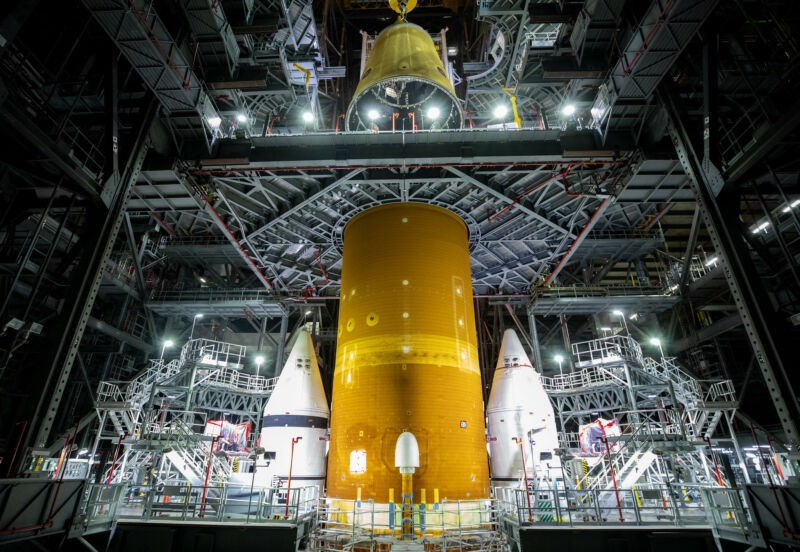
Publicly NASA is still holding onto the possibility of a 2021 launch date for the debut flight of its Space Launch System rocket. This week, an agency spokesperson told Ars that "NASA is working toward a launch for the Artemis I mission by the end of this year."
However, a source said the best-case scenario for launching the Artemis 1 mission is spring of next year, with summer the more realistic target for a test flight of the heavy lift rocket and Orion spacecraft. The space agency is already running about two months behind internal targets for testing and integrating the rocket at Kennedy Space Center, and the critical pre-flight tests remain ahead.
NASA's Kathryn Hambleton acknowledged that the space agency has seen schedule slips. "The agency continues to monitor the rise of COVID cases in the Kennedy area, which combined with other factors such as weather and first time operations, is impacting our schedule of operations," she said. "Moving step by step, we are progressing toward launch while keeping our team as safe as possible."
Earlier this summer technicians and engineers in Florida completed stacking the SLS rocket, along with its side boosters. A "mass simulator" for Orion was then placed atop the rocket. At present NASA and its contractors are working on vibration tests of the assembled rocket, with the goal of better understanding the difference between the natural vibrations of the full stack versus those caused by external forces. This information will be fed into flight software.
NASA originally hoped to complete this work in July, but Hambleton confirmed to Ars that this vibration, or "modal" testing, is ongoing in the Vehicle Assembly Building at Kennedy Space Center.
Following this testing, the mass simulator will be removed, and the Orion spacecraft with its launch abort system will be stacked carefully on top of the rocket. This process may take a few weeks. Following this assembly and further tests, the SLS stack will be rolled to Launch Pad 39B for a "wet dress rehearsal," during which the vehicle will be fueled and much of an actual countdown simulated. However, the vehicle's engines will not be fired. A source said this wet-dress test will likely take place in November or December.
Following this test, the vehicle will be rolled back into the Vehicle Assembly Building for final checks and closeouts. Assuming the wet dress rehearsal proceeds nominally and other activities continue on schedule, the SLS rocket could launch next spring. However if there are further delays, or if the wet dress rehearsal identifies new issues, the launch would more likely slip to next summer.
Hambleton said NASA plans to soon offer an update on launch dates. After modal testing and stacking of Orion on top of the rocket, she said the agency will release a projected date for the wet dress rehearsal and the launch of the rocket itself. "As always, we will fly only when we are ready," she said.
Although years late and many billions of dollars over budget, the launch of this rocket will in some ways be a minor miracle. For a large bureaucracy like NASA, completing complex human spaceflight tasks is difficult. And the SLS rocket is complex both technically and politically.
Concerned about job losses after the space shuttle retired, Congress imposed this rocket on the space agency, down to dictating its various components to ensure that space shuttle contractors such as Boeing, Lockheed Martin, Northrop Grumman, and Aerojet Rocketdyne continued to receive substantial space program funding. Each contractor was given a "cost plus" contract that ensured funding but provided little incentive for on-time delivery.
The legislation creating the Space Launch System was passed in October 2010, at which time the rocket was expected to be ready for operations in 2016. One of the key legislators behind the rocket's creation was then Florida-Senator Bill Nelson. He relentlessly fought against the Obama administration's effort to see if private companies, such as United Launch Alliance and SpaceX, could more efficiently build a large rocket for NASA. The space agency and its traditional contractors could do the job better than anyone, he said.
"This rocket is coming in at the cost of what not only what we estimated in the NASA Authorization act, but less,” Nelson said at the time. “The cost of the rocket over a five- to six-year period in the NASA authorization bill was to be no more than $11.5 billion.” Later, he went further, saying, "If we can't do a rocket for $11.5 billion, we ought to close up shop."
More than a decade later, NASA has spent more than $20 billion to reach the launch pad. And Nelson is no longer a US Senator, he is the administrator of the space agency. The shop remains open.
https://news.google.com/__i/rss/rd/articles/CBMibmh0dHBzOi8vYXJzdGVjaG5pY2EuY29tL3NjaWVuY2UvMjAyMS8wOC9uYXNhcy1zbHMtcm9ja2V0LXdpbGwtbm90LWZseS11bnRpbC1uZXh0LXNwcmluZy1vci1tb3JlLWxpa2VseS1zdW1tZXIv0gF0aHR0cHM6Ly9hcnN0ZWNobmljYS5jb20vc2NpZW5jZS8yMDIxLzA4L25hc2FzLXNscy1yb2NrZXQtd2lsbC1ub3QtZmx5LXVudGlsLW5leHQtc3ByaW5nLW9yLW1vcmUtbGlrZWx5LXN1bW1lci8_YW1wPTE?oc=5
2021-08-31 13:07:23Z
52781849164132
Tidak ada komentar:
Posting Komentar